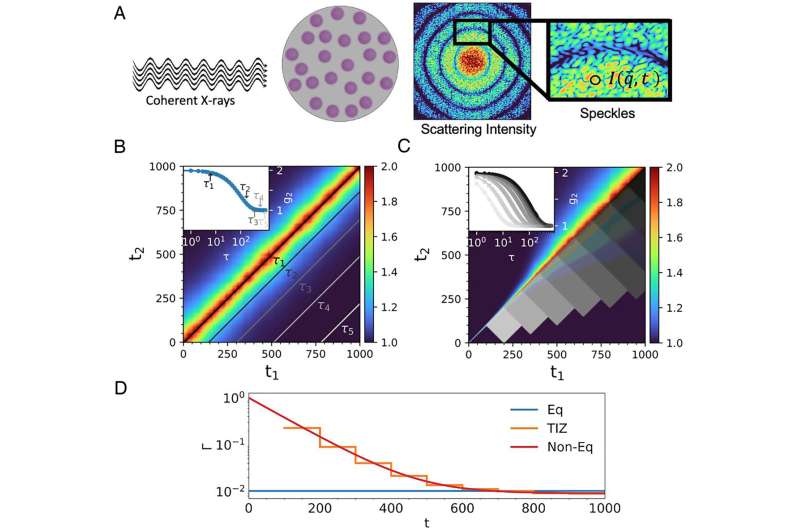This article has been reviewed according to Science X's editorial process and policies. Editors have highlighted the following attributes while ensuring the content's credibility:
fact-checked
peer-reviewed publication
trusted source
proofread
Ability to track nanoscale flow in soft matter could prove pivotal discovery

For roughly 70 years, Play-Doh has been entertaining children with its moldable, squishy form. This familiar substance belongs to a broader category known as soft matter, which includes some foods (such as mayonnaise), 3D printer gels, battery electrolytes and latex paint.
Scientists from the U.S. Department of Energy's (DOE) Argonne National Laboratory and the Pritzker School of Molecular Engineering at the University of Chicago report a groundbreaking advance for better understanding and improving the flow properties of soft matter at the atomic level (nanoscale). This advance depends upon a state-of-the-art technique called X-ray photon correlation spectroscopy (XPCS).
The research is published in PNAS.
"Soft matter is easily deformed," explained Matthew Tirrell, a senior advisor and senior scientist at Argonne and an emeritus professor at the University of Chicago. "Its properties are highly responsive to outside stimuli, such as a force, temperature change or chemical reaction."
Tirrell gave paint as an example. When paint is applied to walls, highly complex flows occur at the nanoscale, but when the brushing or rolling is stopped, one wants flow to stop so the paint does not drip down the wall.
"In a nutshell, we developed a new technique to characterize the complicated fluctuations that soft matter nanoparticles undergo while being subjected to something like an applied force or temperature change," said graduate student and lead author HongRui He, who worked on this project as part of the Graduate Research Cooperative program. In this program, he is pursuing his Ph.D. at the University of Chicago while conducting his research at Argonne.
Until now, no one has been able to precisely determine the flow behavior and interactions of these nanoparticles over time and correlate them with the bulk flow properties. "Previous XPCS experiments required averaging collected data, which led to the loss of crucial information about the complex processes at the nanoscale," noted Wei Chen, an Argonne chemist.
The team's innovative method allows scientists to determine a key factor, the transport coefficient, based on XPCS data. This coefficient measures the flow in a material. Determining it is essential to understanding how soft matter moves and changes over time in response to an external stimulus.
To gain the needed XPCS data requires a special X-ray beam like that available at the Advanced Photon Source (APS), a DOE Office of Science user facility at Argonne. This beam is sensitive to any disorder in the material over time at the nanoscale.
The team tested their XPCS method with a complex soft material — a dense mixture of spherical charged particles in a salt solution. Shearing was the force applied to the material at beamline 8-ID-I of the APS.
"Shearing occurs when you spread thick lotion on your hands and rub them together," explained Suresh Narayanan, a physicist and group leader at the APS.
The shearing results provided valuable insights into the changing flow properties and deformities in this salt-containing mixture. At the start, three bands of nanoparticles formed: fast moving, slow moving and static.
After 15 seconds, the fast-moving band vanished. About 40 seconds later, the three bands returned. These findings are beyond the reach of current analysis methods and mark a major leap forward for XPCS analysis relevant to many different types of soft matter.
"This XPCS development is very timely for future work due to the significant increase in beam brightness with the APS upgrade," said Narayanan. "What's more, it holds potential for studying natural phenomena, such as landslides, earthquakes and the growth of plaque in arteries. Understanding these fluctuations in flow at the nanoscale could help predict future changes on a larger scale."
The in-progress upgrade to the APS includes a brand-new suite of beamlines at 8-ID dedicated to XPCS. The new beamlines will make use of the improved X-ray beam to enhance XPCS research going forward. New experiments are expected to begin at the upgraded APS later in 2024.
The team used the Center for Nanoscale Materials, another DOE Office of Science user facility at Argonne, to characterize the particles in the salt solution.
More information: HongRui He et al, Transport coefficient approach for characterizing nonequilibrium dynamics in soft matter, Proceedings of the National Academy of Sciences (2024). DOI: 10.1073/pnas.2401162121
Journal information: Proceedings of the National Academy of Sciences
Provided by Argonne National Laboratory





















